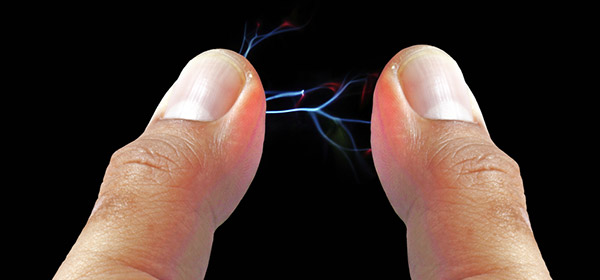Have you ever gone to open your car door and received a small electric jolt? Or reached for a shopping trolley in the supermarket and the same thing happened? What causes these electric shocks?
Just like the ancient Greeks, we tend to think static electricity occurs from rubbing things together. As in the example above, if you walk across a linoleum floor at the supermarket you will build up a static charge which discharges when you touch the handle of a shopping trolley, and gives you an electric shock.
When you were at school you may have tried the science experiment where you rub a balloon on your jumper and it sticks to you; or you hold the balloon close to your hair to make it stand on end. You probably concluded that the act of rubbing something produces a build-up of electrical energy.
However, it’s not the rubbing that’s the important factor. It’s the fact that you bring two different materials into contact, thereby producing static electricity. All materials are built from atoms which have a positive core surrounded by electrons. Some atoms have a more powerful pull on electrons than others. You can see this when you put two different materials in contact, and one attracts electrons more than the other.
It is possible for electrons to be pulled from one material to another, and when separated, electrons will be pulled to the material that strongly attracts them. The result is that one of the materials has gained some extra electrons (therefore becoming negatively charged) while the other material has lost some electrons (becoming positively charged), thus creating static electricity.
When materials are rubbed together over and over again, the chances of more atoms taking part in this electron-swap are increased.
Materials can be ranked in order of the charge, positive or negative, they gain when rubbed. This list is called the triboelectric series. The materials that are further apart in this series will create an increase in static electricity when you rub them together.
So, static electricity is not just created by rubbing two materials together, but by the nature of the materials brought into contact.
Okay, so with static electricity now explained, have you ever wondered why it’s worse in winter?
According to Science Buddies, “the reason winters are more shock-prone has to do with the moisture in the air. In winter, static electricity builds up in our homes because the air is drier. In summer, however, water in the air can help dissipate the electrons that we pick up as we move around. But when the air is drier, the charge collects and clings to us, building up until … zap!”
Now you know!
Were you aware of the true cause of static shocks? Have you noticed that they are worse in winter?
Related articles:
How to use less electricity
Does coffee help you lose weight?
Do copper bracelets ease arthritis?

